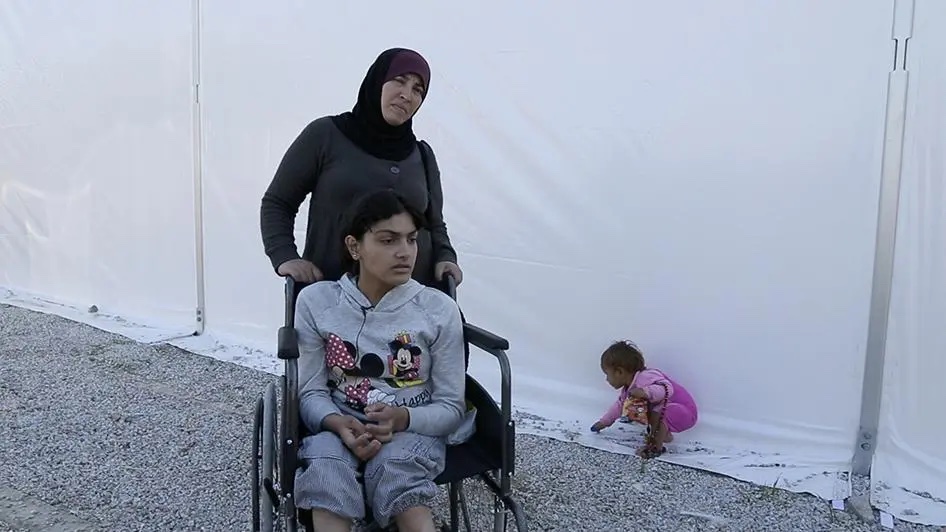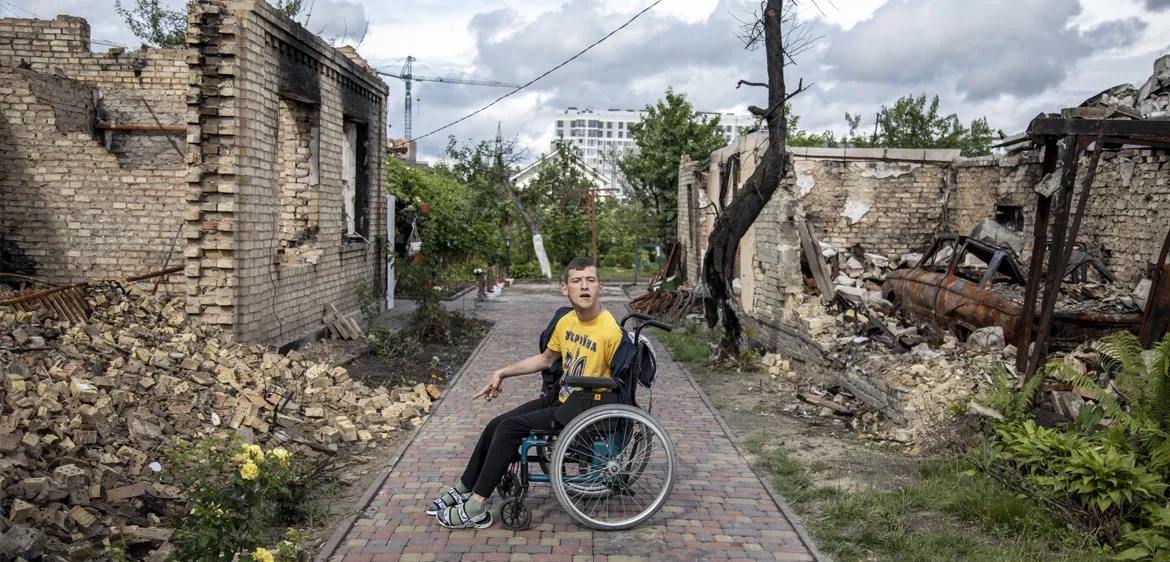Image: Young man in a wheelchair amidst the rubble of war
The Impact of Armed Conflict on People with Disabilities
July 26, 2024 marked the 34th anniversary of the passing of the Americans with Disabilities Act. Over the past 34 years, people with disabilities who have US citizenship have gained greater access to community living, accessible transportation, and equitable employment, and we have made significant advances in fighting societal ableism and gaining broader social acceptance.
But in parts of the world affected by war, genocide, and other forms of state-sanctioned violence, people with disabilities are not able to fight for legal rights or cultural acceptance. Rather, they are fighting for their lives as they are disproportionately affected by the violence and horror that plague their nations.
In 2021, Human Rights Watch (HRW) presented a report on people with disabilities in conflict zones to the UN Special Rapporteur on the Rights of Persons with Disabilities. HRW based their report on research they conducted in eight countries facing “armed conflicts and humanitarian emergencies,” starting in 2015. They consulted people with disabilities, including activists, in the affected regions to ensure their information was accurate.
Safety from Attacks
Many people in war zones are forced to flee from their homes to avoid being killed, and often need to keep moving from place to place continually, rather than being able to settle in a “safe zone” that will remain safe. This is difficult for everyone, but even more so for people with disabilities. Those with mobility-related disabilities are often unable to flee violence, especially if their assistive devices have been destroyed or stolen – home destruction and looting being common practices in war. Blind people and those with low vision may be unable to flee unless assisted by others due to issues navigating a changed environment. Deaf people and those with hearing impairments may be unable to flee in time due to not hearing auditory cues of attacks, such as the sounds of bombs or gunfire.
In at least one conflict zone, HRW documented that the armed forces would give only a few minutes’ warning to the targeted population before hitting them with airstrikes. This was not nearly enough time for most people with disabilities to escape.
HRW reported frequent cases of older adults with disabilities staying behind or being left behind in villages that were under attack, facing death by armed forces or by starvation, so that their family members would be able to flee faster and have a better chance at survival.

Image: Displaced people who are blind crouching near a wall
Access to Assistive Technology
When people with disabilities are able to survive by fleeing their homes, they lose all accessibility adaptations that their homes had, and have no guarantee that any shelter they find will be accessible. Their assistive devices may be damaged or lost, and cannot be repaired or replaced: governments can prevent targeted groups from importing assistive tech, and humanitarian aid groups do not typically bring such devices to distribute.
Even people with disabilities who are able to shelter in their homes face the loss of their assistive tech, either through direct property destruction or due to electricity being cut off, preventing the use of chargeable devices like scooters and hearing aids. Again, if those people ever have to flee later, they may not be able to escape their homes in time.
Access to Basic Necessities
Violence from war and armed conflict, including state-sanctioned conflict, restricts access to food, sanitation, and health care for everyone in the targeted population, but people with disabilities are disproportionately affected.
When food is distributed to refugee camps, the distribution is often done in a disorganized “first come, first served” manner, so people must rush to the site and often physically fight over the limited food supply to ensure they can get enough for their families. HRW quoted one displacement camp resident with a disability who reported that those unable to fight for access to food “must watch from the sidelines and just try to get what is left over.”
Sanitation conditions in besieged areas and refugee camps are usually very poor, including the presence of potentially severe illness-causing bacteria, viruses, and parasites. Latrines and shower facilities are not designed for universal access, so people with disabilities are often only able to reach them by crawling along the dirty ground, which both strips them of dignity and increases their risk of disease.
While the HRW report did not mention this, genocidal regimes have been known to specifically target hospitals. The destruction of hospitals greatly limits everyone’s access to health care, but it is a death sentence for people with disabilities who need regular medical care, such as dialysis, or life-saving medicine, such as insulin.

Image: Older woman with a younger woman using a wheelchair in a refugee camp
Stigma and Abuse
All refugees face severe adversity, but for refugees with disabilities, these problems are further compounded by societal stigma. For example, displacement disrupts children’s schooling, which is important for both education and socialization. Refugee children are sometimes able to attend schools in their new locations, but schools may charge significant additional fees for students with disabilities, or may not accept them at all. Some refugee camps have schooling programs, but these are often inaccessible; HRW noted that in one camp’s school that had 3,797 displaced children enrolled, only 14 were children with disabilities.
People with disabilities are already vulnerable to abuse due to stigma and lack of protections, and according to HRW, the harsh conditions and scarcity of resources in communities targeted by state violence can exacerbate the stigmatization. People with disabilities may face physical and verbal abuse, as well as theft of their belongings, from others in their community. Those with what HRW calls psychosocial disabilities, including intellectual and developmental disabilities and mental illnesses, do not have access to any support services, and are often shackled in place by their family members. HRW has reported hundreds of thousands of cases of this inhumane practice worldwide, not limited to conflict zones, but violent conflict increases its frequency: when people with disabilities are orphaned, they may be placed with extended family members who then abuse them.
The stigma against people with disabilities is also often held by soldiers and other wartime actors. The armed forces attacking these populations may specifically target people with disabilities, whether due to their higher vulnerability or to the attackers’ prejudice. HRW reported an incident where soldiers shot and killed a man with developmental and hearing disabilities because he did not answer their questions, and another incident where soldiers nearly killed a disabled teenager after calling her an animal. People with disabilities, especially women and girls, are also at higher risk of sexual assault, which is frequently committed by armed forces during war and conflict.
Violence against people with disabilities does not result only from individual soldiers’ ableism, but can be deliberate policy by a genocidal state. The Nazi government ordered and committed the murder of up to 300,000 people with disabilities in psychiatric institutions (Aktion T4: [link]).
Psychological Harm
Everyone in a conflict zone, even those who have not been directly attacked, has had some kind of traumatic experience: the environment itself is traumatic. The terror of living under the constant threat of violence has devastating psychological effects, both in the short and long term. In one country where violence has raged for 40 years, it is estimated that an entire half of the population experiences depression, anxiety, and/or post-traumatic stress disorder (PTSD).
The PTSD triggers that can occur in conflict zones include not only startling but innocuous loud noises, but also actual recurrences of bombing and airstrikes. People with disabilities are also aware that they may not be able to escape hostilities, which is a source of severe anxiety.
As limited as access to physical health care in conflict zones is, mental health care is even less available.
Children are especially vulnerable to psychological harm, and this is compounded for children with disabilities. Displacement and the threat of violence are extremely damaging to children’s mental and emotional stability. HRW quoted one mother, whose children include a son with multiple disabilities, saying that her children had “no hopes for the future.”

Image: Man with limb loss (legs) using a wheelchair
Armed Conflict Causes Disability
The HRW report is focused on the way people with existing disabilities are impacted by armed conflict, but beyond the scope of the report looms another issue: armed conflicts are mass disabling events.
According to the UN, 16% of people with disabilities worldwide acquired their disabilities from armed conflict. The anxiety, depression, and PTSD that result from living in a conflict zone are disabilities in themselves. Injuries from weapons like bombs and landmines result in limb loss for hundreds of thousands of people, with amputations usually performed under horrific conditions. Poor sanitation can also cause disability, as in one current conflict zone where refugees under threat of genocide are now facing an outbreak of polio.
In short, armed conflict causes huge numbers of people to become disabled and causes disproportionate harm to people with disabilities. This is a disability rights issue.
Those of us who benefit from the advancement of disability rights in the US must be in solidarity with and support the rights of people with disabilities around the world. Awareness is the first step. From there, we can appropriately advocate for disability rights and the peaceful resolution of armed conflict as a way to increase safety, equality, and well-being for people with disabilities around the world.

Image: Man helping another using a wheelchair in a refugee camp





